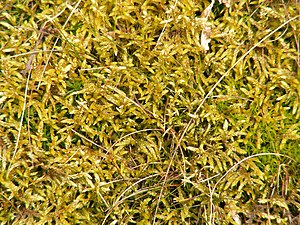Red stem moss
| Red stem moss | ||||||||||||
|---|---|---|---|---|---|---|---|---|---|---|---|---|

Red stem moss |
||||||||||||
| Systematics | ||||||||||||
|
||||||||||||
| Scientific name | ||||||||||||
| Pleurozium schreberi | ||||||||||||
| ( Brid. ) Mitt. |

The red stem moss ( Pleurozium schreberi ) is a common moss in European forests and heaths.
features
They are strong mosses with up to 15 cm long stems. At the front end they are loose, but more or less regularly simply pinnate. The stems themselves are red in most plants and shimmer through the pale green leaves.
The leaves of the stems are broadly ovate and have a blunt tip at the front. They are hollow and lie on top of each other in the shape of roof tiles, so that the trunks look like small worms. The leaves of the branches are similar but narrower. A vein is missing or short and double.
Capsules are rarely formed from this moss.
distribution
The red stem moss occurs in the temperate and cool areas of the northern hemisphere and in the Andes . In the mountains it rises above the tree line. It is one of the most common mosses in the forests of the northern hemisphere and can form pure mass stands on the forest floor. Just as often it also grows in company with other mosses such as Hylocomium splendens , Dicranum scoparium or Hypnum cupressiforme .
It prefers acidic soils. Otherwise it is quite undemanding. You can find it in forests, heaths and moors .
Others
The moss was named after the German botanist Johann Christian Daniel von Schreber , a student of Linnaeus .
Since the species strongly accumulates metals and other pollutants, their concentration in the plants can be used to investigate pollutant inputs ( biomonitoring ). A method for recording the regional nitrogen deposition using red stem moss was standardized with the VDI guideline VDI 3957 Part 19 .
literature
- Jan-Peter Frahm , Wolfgang Frey : Moosflora (= UTB . 1250). 4th, revised and expanded edition. Ulmer, Stuttgart 2004, ISBN 3-8252-1250-5 .
Web links
Individual evidence
- ↑ VDI 3957 sheet 19: 2009-12 Biological measurement methods for determining and assessing the effects of air pollution (bioindication); Detection of regional nitrogen deposits with the deciduous moss Scleropodium purum and Pleurozium schreberi (Biological measurement procedures to determine and assess the effects of ambient air pollutants (bioindication); Detection of regional nitrogen depositions with the mosses Scleropodium purum and Pleurozium schreberi). Beuth Verlag, Berlin, pp. 3–5.
- ^ Karsten Mohr: Biomonitoring of nitrogen deposition with mosses. In: Hazardous substances - cleanliness. Air . 74, No. 6, 2014, ISSN 0949-8036 , pp. 263-265.
